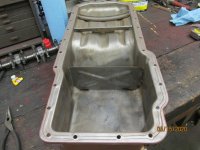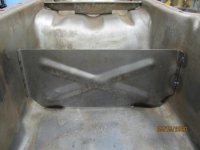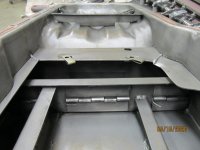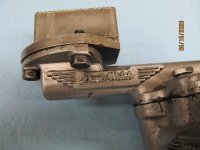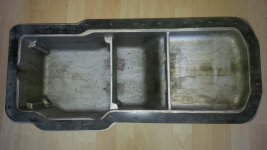'67 BJ8 with recently rebuilt engine and finned cast AL alloy oil pan by PO.
This could be a DW or Moss pan; they look similar from photos,
7.75 Qts (= 7.3 litres) of VR1 shows marginally above top dip stick mark.
My manual says 7.25 litres capacity including filter
Oil cooler fitted.
Normal running and idle OP is fine at hot 48/38 psi
cold 60/50
When oil is really hot - after a run after and after moderate hard braking say from 60 MPH (not panic stop) OP falls to zero for about 2-3 secs before recovering to normal - around 48 psi. Not noticed when oil is cold. Obviously hot oil slushing forward leaving pump sucking air. Oil pan does have the internal baffle.
I have a oil temp gauge and it does take a while for oil to get really hot ... about 45 mins to 170F
So what gives ?
Others have suggested that the oil pump pickup needs to be trimmed if DW high output pump?
Have no idea if this was done by PO or what sort of pump it is.
If this is the case then I don't understand why normal running OP is not affected ?
Maybe other cars do this unnoticed ?
Ideas welcome.
This could be a DW or Moss pan; they look similar from photos,
7.75 Qts (= 7.3 litres) of VR1 shows marginally above top dip stick mark.
My manual says 7.25 litres capacity including filter
Oil cooler fitted.
Normal running and idle OP is fine at hot 48/38 psi
cold 60/50
When oil is really hot - after a run after and after moderate hard braking say from 60 MPH (not panic stop) OP falls to zero for about 2-3 secs before recovering to normal - around 48 psi. Not noticed when oil is cold. Obviously hot oil slushing forward leaving pump sucking air. Oil pan does have the internal baffle.
I have a oil temp gauge and it does take a while for oil to get really hot ... about 45 mins to 170F
So what gives ?
Others have suggested that the oil pump pickup needs to be trimmed if DW high output pump?
Have no idea if this was done by PO or what sort of pump it is.
If this is the case then I don't understand why normal running OP is not affected ?
Maybe other cars do this unnoticed ?
Ideas welcome.

 Hi Guest!
Hi Guest!

 smilie in place of the real @
smilie in place of the real @
 Pretty Please - add it to our Events forum(s) and add to the calendar! >>
Pretty Please - add it to our Events forum(s) and add to the calendar! >> 

